Where In Italy Is Genoa?
If you're wondering "where in Italy is Genoa?", you've come to the right place! Genoa, or Genova in Italian, is a stunning coastal city that sits proudly in the northwestern region of Liguria.
This magnificent port city hugs the Mediterranean coastline and serves as the capital of the Liguria region, making it one of Italy's most important maritime centers. You'll find Genoa nestled between the sparkling Ligurian Sea and the rolling hills of the Italian Riviera, creating a dramatic backdrop that's absolutely breathtaking.
Where is Genoa Italy located exactly? Picture this: Genoa sits roughly halfway along Italy's northwestern coast, about 120 kilometers south of Milan and 190 kilometers northwest of Florence.
The city stretches along a narrow coastal strip, with the Apennine Mountains rising dramatically behind it. This unique geography creates a natural amphitheater effect, where colorful buildings cascade down hillsides toward the bustling harbor below.
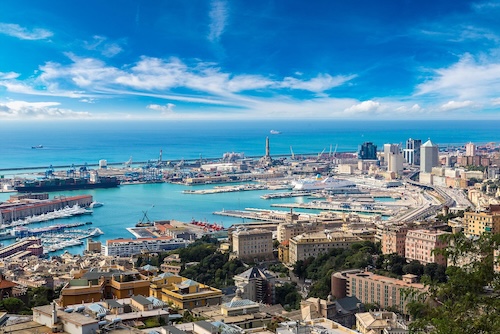 A panorama of the Port of Genoa
A panorama of the Port of Genoa
Where in Italy is Genoa?
Getting to Genoa is surprisingly easy, no matter where you're coming from. If you're flying in, Genoa's Cristoforo Colombo Airport is just six kilometers from the city center, making it incredibly convenient for travelers.
The airport connects to major European cities, though it's smaller than Rome or Milan's airports. Don't worry though – the compact size means you'll be through customs and on your way in no time.
For those who prefer train travel, you're in for a treat! Genoa's main railway stations, Genova Centrale and Genova Brignole, connect the city to Italy's extensive rail network. High-speed trains from Milan take just over an hour, while trains from Rome clock in at around four and a half hours. The coastal route from Nice, France, offers some of the most spectacular scenery you'll ever see from a train window.
If you're driving, the A10 and A12 highways provide excellent access to Genoa. The A10 runs along the coast from the French border, while the A12 connects to Tuscany and central Italy.
Just be prepared for some impressive tunnels and viaducts – the mountainous terrain means the highways are engineering marvels in themselves. Parking in the city center can be challenging, so consider staying at a hotel with parking or using one of the park-and-ride facilities.
Once you arrive, you'll quickly discover that Genoa is a city of incredible contrasts. The historic center, one of Europe's largest medieval quarters, winds through narrow caruggi (alleyways) that have remained virtually unchanged for centuries. These atmospheric streets are where locals still live, work, and shop, giving you an authentic taste of Genoese life that many tourists miss in other Italian cities.
What to see in Genoa starts with the magnificent Cathedral of San Lorenzo, the city's spiritual heart. This stunning Romanesque-Gothic cathedral survived a World War II bomb that failed to explode – you can still see the unexploded shell displayed inside! The black and white striped marble facade is absolutely striking, and the treasury houses the Holy Grail, according to local legend.
 Cathedral of San Lorenzo
Cathedral of San LorenzoThe Palazzo Rosso and Palazzo Bianco are must-visit museums that showcase Genoa's incredible artistic heritage. These former noble residences house works by Van Dyck, Rubens, and other masters who were drawn to Genoa during its golden age as a maritime republic. The opulent rooms themselves are works of art, with frescoed ceilings and period furnishings that transport you back to the city's wealthy past.
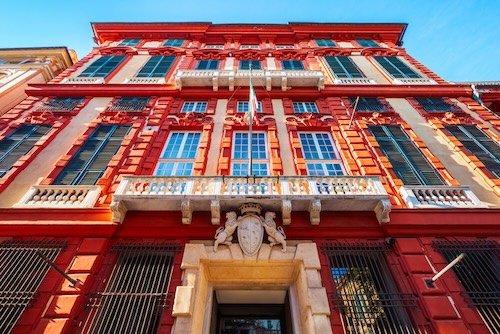 The Palazzo Rosso in Genoa
The Palazzo Rosso in GenoaDon't miss the Christopher Columbus House, a modest stone building where the famous explorer supposedly spent his childhood. While historians debate the exact details, there's something magical about standing in the place where the man who changed the world might have taken his first steps. It's a quick stop that connects you to one of history's most significant figures.
Genoa Must-See Attractions Walking Tour With A Guide
Another option while in Genoa is to book a Walking Tour with our trusted partner Viator.
Delve into the vibrant streets of Genoa on a walking tour, starting at the iconic Plaza de Ferrari, the city's lively hub. Traverse through centuries of history at the majestic Palazzo Ducale, a grand palace resonating with tales of the past. Witness the medieval charm of Torri di Porta Soprana, a historic gateway showcasing Genoa's architectural heritage.
Explore the birthplace of Christopher Columbus at Casa di Colombo, steeped in maritime history. Immerse yourself in the mystical atmosphere of Genoa at Pozzo di Giano, an ancient well with mythical significance. Continue your journey through the city's treasures, including Piazza San Giorgio, Cattedrale di San Lorenzo, and Piazza Banchi, each offering unique insights into Genoa's rich cultural heritage.
Read more and book - Genoa Must-See Attractions Walking Tour With A Guide
Where in Italy is Genoa?
The Via del Campo is one of Genoa's most atmospheric streets, immortalized in song by Italian singer-songwriter Fabrizio De André. This narrow medieval street buzzes with local life, from tiny shops selling everything from spices to vintage clothing. It's here that you'll really feel the pulse of authentic Genoa, away from the more touristy areas.
 Via del Campo, Genoa
Via del Campo, GenoaFor breathtaking views, take the funicular railway up to Righi or Granarolo. These historic cable cars climb the steep hillsides, offering spectacular panoramas of the city, harbor, and coastline. The ride itself is an adventure, and once you reach the top, you'll understand why Genoa is called "La Superba" – the proud one.
 The funicular railway
The funicular railwayThe old port area, redesigned by renowned architect Renzo Piano for the 1992 Columbus celebrations, is now a vibrant waterfront district. The iconic crane structure, Il Bigo, offers a 360-degree view from 40 meters above the harbor. You'll also find the excellent Aquarium of Genoa here, one of Europe's largest and most impressive marine attractions.
Speaking of the aquarium, it's absolutely worth dedicating half a day to this incredible facility. Home to dolphins, sharks, penguins, and countless other marine species, it's designed to take you on a journey through different aquatic environments. The dolphin exhibit is particularly moving, and the tropical sections will transport you to distant coral reefs.
The Palazzo Reale is another gem that many visitors overlook. This baroque palace showcases the incredible wealth of Genoa's noble families, with rooms decorated in silk, gold, and precious stones. The throne room and hall of mirrors are particularly spectacular, rivaling anything you'll find in other European palaces.
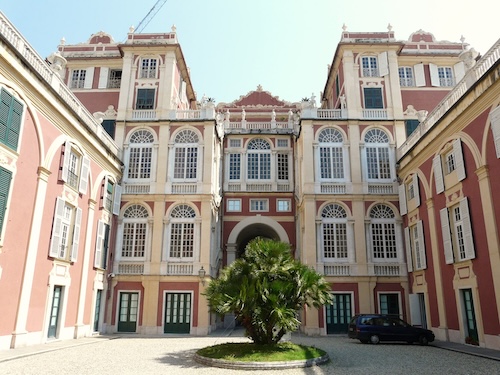 Palazzo Reale in Genoa
Palazzo Reale in GenoaFor a unique experience, explore the Palazzo Spinola, a perfectly preserved 16th-century noble residence. Unlike many museums, this palace maintains the feeling of a lived-in home, complete with original furniture, artwork, and even kitchen utensils. It's like stepping back in time to experience how Genoa's aristocracy actually lived.
The Mercato Orientale is where locals shop for fresh produce, and it's a feast for all your senses. Located in a beautiful 19th-century market hall, you'll find the freshest seafood, aromatic herbs, and seasonal vegetables. Even if you're not cooking, it's worth wandering through to soak up the authentic atmosphere and maybe grab some fresh focaccia.
Now let's talk about food – and in Genoa, that means starting with focaccia. This isn't the thick, heavy bread you might know; Genoese focaccia is thin, crispy, and often topped with olives, onions, or cheese. The best places are tiny bakeries tucked into the caruggi, where locals queue up for their daily bread. Try Il Forno di Via del Campo for an authentic experience.
Pesto was born in Genoa, and you haven't really tasted it until you've had it here. The secret is the local basil, which has a unique flavor thanks to the Mediterranean climate and sea air. For the best pesto experience, head to Il Genovese in the old town, where they still make it by hand with a marble mortar and pestle, just like nonna used to do.
For seafood lovers, Antica Osteria di Vico Palla is a hidden gem that locals guard jealously. Tucked away in a narrow alley, this tiny restaurant serves the freshest catch of the day prepared simply and perfectly. The fritto misto (mixed fried seafood) is legendary, and the atmosphere is pure Genoa – no frills, just incredible food and passionate owners.
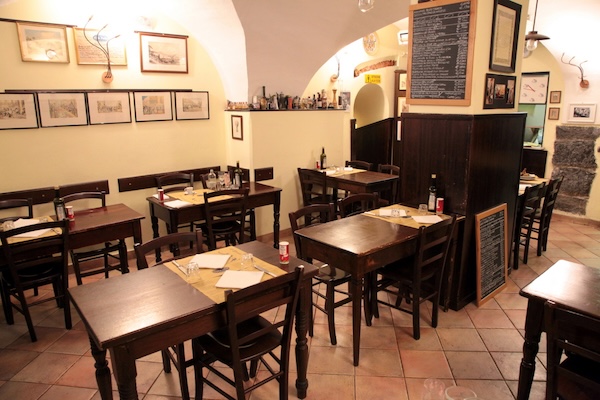 Osteria di Vico Palla
Osteria di Vico PallaWhat to see in Genoa
If you want a meal with a view, head up to La Pineta restaurant on the hillside. This family-run trattoria offers stunning panoramic views over the city and sea, especially beautiful at sunset. The menu focuses on traditional Ligurian dishes, and the terrace seating makes you feel like you're dining in someone's garden overlooking paradise.
For a truly local drinking experience, seek out the tiny bars in the historic center where dock workers and locals gather for their morning coffee or evening aperitivo. Bar degli Specchi near the cathedral has been serving the neighborhood for decades, and the owner, Signor Giuseppe, knows everyone's usual order by heart.
The rooftop bar at the Hotel Villa Pagoda offers one of the most spectacular sunset views in the city. While it's a bit more upscale than the neighborhood bars, the panoramic terrace overlooking the harbor is worth the splurge. Their Negroni Sbagliato is perfectly crafted, and you'll feel like you're on top of the world.
Here's an insider tip that most tourists miss: take the boat to Camogli, a picturesque fishing village just 30 minutes along the coast. The colorful houses stacked along the waterfront look like something from a postcard, and the seafood restaurants here serve some of the best fish in Liguria. The boat ride itself offers stunning coastal views you can't get any other way.
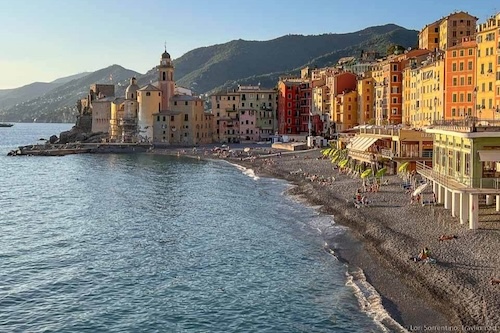 Camogli near Genoa
Camogli near GenoaAnother local secret is the Elevator Spianata Castelletto, a historic Art Nouveau lift that takes you up to one of the best viewpoints in the city. Most tourists don't know about this hidden gem, but locals use it daily. The panoramic terrace at the top offers 360-degree views, and there's a lovely café where you can enjoy an aperitivo while watching the sunset.

The Palazzo Doria Tursi houses the city's most precious artifacts, including Paganini's violin, the Guarneri del Gesù. Music lovers will be thrilled to see the instrument that the legendary virtuoso played, and the palace itself is a masterpiece of Renaissance architecture. The courtyards and gardens provide a peaceful escape from the bustling streets.
For beach lovers, don't miss the nearby Cinque Terre, easily accessible by train from Genoa. These five cliff-top villages offer some of Italy's most dramatic coastal scenery, with hiking trails connecting the towns along precipitous clifftops. It's a perfect day trip that shows you another side of the Ligurian coast.
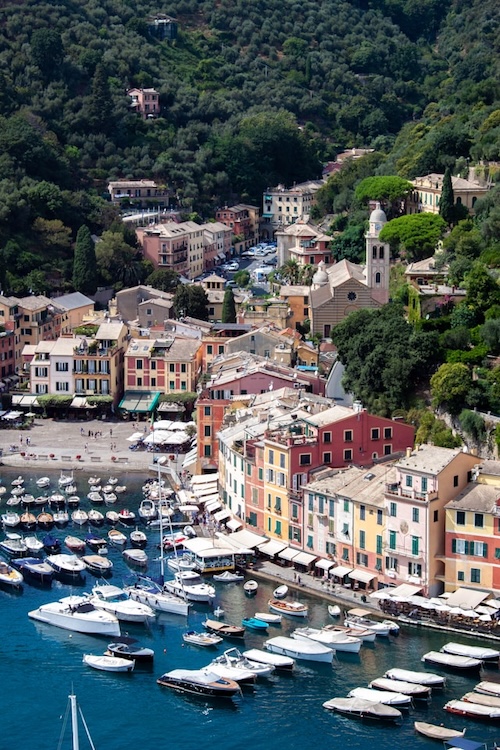 Portofino, Cinque Terre
Portofino, Cinque TerreWhere in Italy is Genoa?
The Genoa Metro is unique – it's one of the few subway systems in the world that includes funicular railways and elevators as part of the public transport network. This makes exploring the city's vertical geography much easier than you might expect. A day pass gives you access to all forms of public transport, including the scenic coastal buses.
Shopping enthusiasts should explore Via del Campo and the surrounding streets for unique finds. You'll discover vintage shops, artisan workshops, and stores selling everything from handmade pasta to locally produced olive oil. The prices are much more reasonable than in tourist-heavy cities like Rome or Venice.
The best time to visit Genoa is during spring (April-May) or fall (September-October) when the weather is pleasant and the crowds are manageable. Summer can be hot and humid, while winter is mild but can be rainy. The shoulder seasons offer the perfect balance of good weather and authentic local atmosphere.
Here's a local tip for getting around: wear comfortable walking shoes! Genoa's historic center is full of steep, narrow streets and staircases. The medieval layout means cars can't access many areas, so walking is often the best way to explore. Plus, you'll discover hidden corners and spectacular views that you'd miss from a vehicle.
Don't leave without trying farinata, a chickpea pancake that's a Genoese specialty. The best place to try it is at Antica Sciamadda, where they've been making it the same way for generations. It's simple, delicious, and completely unique to this region – you won't find authentic farinata anywhere else in Italy.
For accommodation, consider staying in the historic center rather than the modern hotel districts. Palazzo Grillo and Hotel Villa Pagoda offer luxury with character, while smaller B&Bs in converted palazzi give you an authentic taste of living in a medieval city. The narrow streets might seem intimidating at first, but they're perfectly safe and full of life.
So, where in Italy is Genoa? It's right where the mountains meet the sea, where medieval streets wind between Renaissance palaces, and where the spirit of maritime adventure still fills the salty air. This proud city offers an authentic Italian experience that's increasingly rare in our globalized world.
From the moment you arrive until your reluctant departure, Genoa will surprise, delight, and inspire you with its unique blend of history, culture, and natural beauty. Come with an open mind and comfortable shoes, and prepare to fall in love with one of Italy's best-kept secrets.






